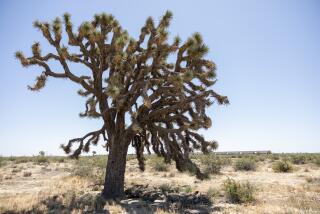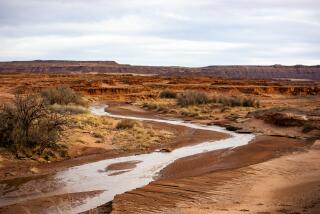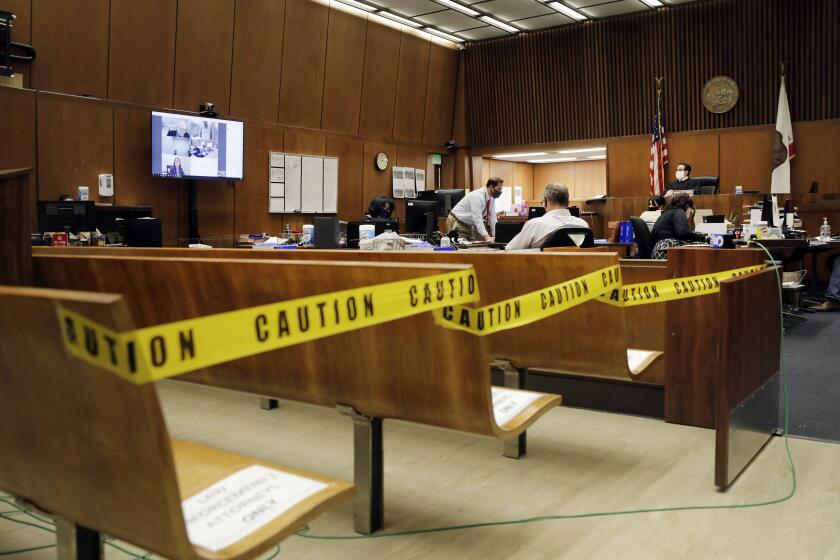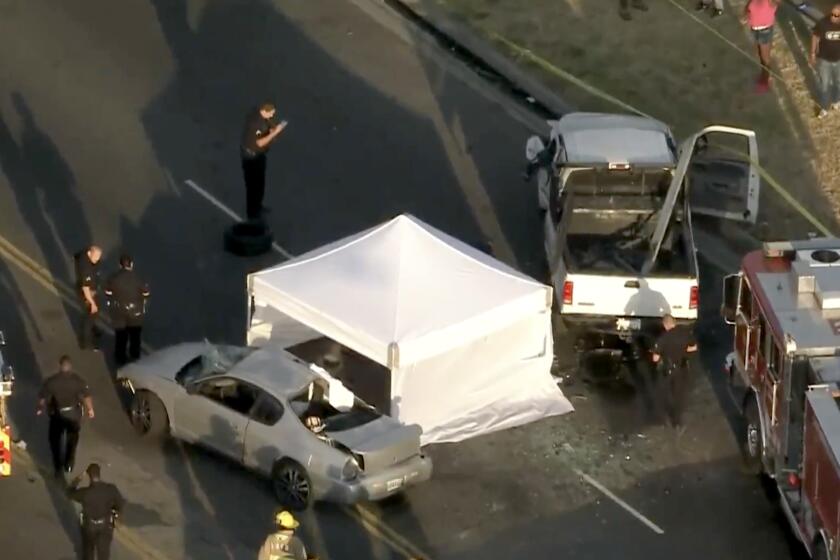Navajos’ desert cleanup no more than a mirage
Most of the mining companies that drilled, dug and blasted for uranium on the Navajo reservation during the Cold War did nothing to repair the environmental damage they left behind. For a time, tribal leaders staked their hopes for a cleanup on Superfund, the landmark legislation that forces polluters to pay for remediation of toxic sites.
More than 1,000 abandoned mines are scattered across the Navajo homeland, which covers 27,000 square miles in Arizona, Utah and New Mexico.
Such a comprehensive cleanup is “exactly what Superfund was designed for,” said Paul Connor, a lawyer who once directed Superfund enforcement policy for the Environmental Protection Agency.
It hasn’t happened. Bureaucratic delays and misunderstandings between the tribe and the EPA have prevented the Navajos from tapping Superfund’s deep pockets and broad legal authority.
Instead, the tribe reluctantly settled for a partial cleanup under a separate program. That effort left many hazards untouched.
One of them is in Church Rock Mine, a Navajo community named for an abandoned uranium site. A 30-foot-high heap of grit and dynamited stone from the mine looms over a cluster of 15 homes. The wind roars for hours at a time, scattering radioactive dust throughout the settlement.
For years, residents appealed to tribal leaders and the U.S. government for help. In 2003, tired of waiting, they joined forces with Navajo activists who were using a foundation grant to conduct radiation testing.
In a dry wash where generations of children had played catch and tag, they discovered elevated radiation levels.
As word spread of the citizen effort, authorities stirred at last. Under pressure from the tribe, the EPA opened negotiations with the mine’s operator, United Nuclear Corp., and its parent, General Electric Co., to clean up the mess.
If the companies eventually foot the bill, it would mark the first time a polluter has been held to account under Superfund for contaminating the reservation.
But like the Church Rock families, members of other Navajo communities are done waiting for the government to act. They have reached out to environmental groups or university scientists, hoping to fashion their own solutions.
“The Navajos need a champion,” said Glynn R. Alsup, a retired Army Corps of Engineers official who served as a liaison to the Navajos. “The EPA and the tribe should be knocking on doors in Congress every year if they need money. I don’t see that happening.”
*
Thwarted efforts
The Navajos allowed intensive uranium mining by private companies starting in the 1940s. The lone buyer of the uranium was the federal government. The nuclear arms race with the Soviet Union was just beginning, and U.S. officials were desperate for material to make atomic bombs.In contracts typed on onion-skin paper, the companies promised to leave the land “in as good condition as received.” The federal Bureau of Indian Affairs approved all leases and was supposed to enforce their terms.
When demand for uranium eased in the late 1950s, mines and processing mills began to close. The operators often left behind open tunnels and shafts and piles of radioactive tailings. Rarely did they fence off the sites or post warning signs. Federal inspectors knew of the hazards but seldom intervened.
Decades passed. As former miners were dying of lung cancer and respiratory disease in the 1970s, their widows started to wonder whether they and their children were endangered by the detritus of the uranium boom.
In 1982, the tribal government demanded $6.7 million from a federal claims court to seal and clean about 300 mines. The tribe argued that federal inspectors had failed to enforce safety standards in order to keep down the price of bomb material.
A judge rejected the claim in 1985, calling the allegations “entirely speculative.”
Next, tribal officials considered suing the mining companies. But a legal consultant advised that victory was unlikely because the firms had operated and departed with government approval.
The only other parties possibly liable were tribal members who had staked mineral claims and leased them to outside companies. But few of those Navajos made much money.
Running short of options, the tribe pinned its hopes on Superfund.
*
Superfund criteria
The 1980 law gave the EPA power to identify the worst toxic-waste sites and force polluters to pay for cleanup, health studies, clinics, maintenance and monitoring. If no polluters could be found, EPA could pay for the cleanup from its $1.6-billion trust.To get a site on Superfund’s priority list, the tribe had to document the pollution. So staff members of the Navajo environmental commission, established in 1972, went from mine to mine, assessing contamination levels.
As they drove near New Mexico’s Haystack Butte in 1990, their radiation detector began beeping. They determined that the radiation was coming from two mining complexes just outside the reservation. More than 50 Navajos lived within half a mile. Inspectors from the federal Centers for Disease Control and Prevention declared a health emergency.
Determining who was responsible for the contamination proved arduous. Most of the mine operators had vanished. The Department of Energy paid to clean a part of the site once leased by the Atomic Energy Commission. Another portion was owned by the Atchison, Topeka & Santa Fe Railway. A subsidiary had mined there, and the railroad agreed to pay for cleanup.
The EPA did not pursue any other companies and ultimately paid for the balance of the cleanup — $500,000. The work was finished in 1992.
Sadie Hoskie, then the Navajo environmental administrator, figured there had to be another way. Restoring the reservation one mine at a time would take too long.
“We were concerned about the health impacts on the people,” recalled Hoskie, who was working for the Navajos while on leave from a position at the EPA. “Their daily lives were not as safe as they believed.”
In 1993, Hoskie went to Washington to complain. She told members of two House subcommittees that the Navajos wanted “speedy, thorough and permanent remediation of all sites.”
Of 42 abandoned mines investigated by her staff, 28 were hazardous under Superfund criteria. But none had made it onto the national priority list — a sought-after status that all but assured the EPA would put its money and muscle behind a cleanup.
The reservation’s low population density worked against the Navajos in the Superfund ranking system. The process “has proven a failure and must be changed,” Hoskie said.
Rep. George Miller (D-Martinez) criticized the “piecemeal and uncoordinated approach” that “fails to eliminate the radiation health hazard.”
Bill Richardson, then a Democratic congressman from New Mexico and now the state’s governor, said the work at Haystack Butte was “all well and good, but “there must be a final and complete way to address the problems of cleanup.”
*
Disagreements
To Hoskie, King Tutt Mesa illustrated the need for a comprehensive approach.The rock tabletop in the reservation’s northeast section was once the domain of a Navajo couple named King and Despah Tutt.
From 1953 to 1958, the Tutts leased a parcel known as King Tutt No. 1 to a succession of operators, the largest of which was Vanadium Corp. of America.
In 1989, Navajo inspectors visited the abandoned site and found huge mounds of dust and ore rich in uranium and other heavy metals — vanadium, selenium and arsenic. They also found products of uranium’s decay — radium, radon gas, thorium and lead.
About 200 mines had been bored into the mesa. Hoskie suggested lumping them into one Superfund application. She believed that “the sheer number of sites” would make the application hard to reject.
After hearing her House testimony, EPA officials said they would consider the proposal.
In January 1994, tribal and federal officials gathered in Albuquerque to devise a plan for the mesa. But they quickly got bogged down. They couldn’t even agree on the minutes of the meeting.
The Navajos thought the government had committed to pursuing “responsible parties” early in the process and listed this as an “action item” in their summary of the discussion.
After getting a copy, the EPA wrote back: “Please delete as an action item . USEPA did not agree.”
In 1996, federal officials finally concluded that King Tutt Mesa did meet criteria for a Superfund cleanup.
But because there were only 19 homes within three miles, its chances of making the national priority list were uncertain, said Andrew Bain, a regional EPA manager.
There was one sure way to make the cut. The Navajo president, like any state governor, could designate a single site for the national list. If the president wrote a letter, King Tutt Mesa could be the one.
But by then, the EPA was urging the tribe to consider a different path.
*
Another approach
Long before the uranium boom, miners had been digging for coal in Navajo country. Hundreds of spent coal mines dotted the reservation, and by the 1990s the tribe was filling and sealing them.The work was paid for with fees collected from coal mining companies across the country and distributed by the Interior Department. The EPA began pushing the Navajos to use this coal money to seal the uranium mines, too.
Hoskie much preferred Superfund. The coal program wasn’t designed to deal with the complicated issues surrounding the uranium sites.
Superfund gave the EPA the power to clean polluted groundwater that had spread beyond a mining site. The coal program couldn’t pay for that.
Superfund could remove and replace homes built with radioactive waste, a pervasive problem on the reservation. The coal program couldn’t pay for that, either.
Superfund could go after mining companies to pay for cleanups. The coal program couldn’t.
But the coal-fee money had one big advantage: It was readily available.
As for Superfund, even if the tribe put King Tutt Mesa on the national priority list, EPA’s pursuit of the polluters could get tied up in court for years. The hundreds of other Superfund candidates on the reservation faced even longer delays, if they made the list at all.
In May 1994, the Navajos finished sealing entrances to the reservation’s coal mines. The Interior Department certified that the tribe could start using coal money to fill uranium mines.
In the Navajo capital of Window Rock, Ariz., the time had come to make a choice.
Navajo Abandoned Mine Lands, the tribal unit that sealed old mines, was ready to start work on King Tutt “right then and there,” recalled Stanley Edison, a chemist for the Navajo environmental agency.
“We’d been waiting, and the residents had been waiting,” he said.
A partial cleanup trumped none at all, Navajo officials decided.
*
Starting over
Over the next decade, the tribe’s workers sealed about 900 uranium mines, at a cost of more than $25 million. The achievement was substantial: Most of the old pits and shafts no longer presented a temptation to people and animals seeking shelter and water.But Madeline Roanhorse, head of the Abandoned Mine Lands department, noted at a 2004 meeting in Washington that her staff was charged with fixing “physical hazards, not subsurface contamination.”
Another problem is that erosion keeps undoing the tribe’s work. In the desert, drought and wind continually strip the earthen covers off the mines and waste piles, exposing radioactive material. The tribe’s maintenance workers have trouble keeping up with this wearing-away. The task will become harder if Congress approves a proposal to shift more coal-fee money to eastern states.
King Tutt Mesa reflects the limitations of the coal-fee program. Tribal workers have sealed the many shafts and tunnels, but polluted groundwater remains, and condemned homes, built with radioactive waste, still stand nearby.
So the effort to get the site listed for Superfund action is starting over.
On hearing this, Hoskie, now back in the Denver office of the EPA, sighed loudly. “Oh, my goodness,” she said. “I don’t think that the [coal-fee] reclamation is enough . It’s so bureaucratic. Why can’t we rise above it?”
In 1999, Phelps Dodge Corp. swallowed the vestiges of Vanadium Corp. of America. Phelps Dodge is currently spending millions of dollars to clean up 10 former Vanadium Corp. uranium sites in remote canyons in Colorado and Utah. The company acted at the urging of the U. S. Bureau of Land Management and the Forest Service, which were concerned about the safety of hikers and campers.
Whenever Phelps Dodge is informed of such health hazards, “we will of course take responsible action,” company spokesman Kenneth Vaughn said.
Asked why the firm was not cleaning King Tutt Mesa or other Vanadium Corp. sites on the Navajo reservation, Vaughn said there was a simple explanation:
“No one asked.”
*
Turning elsewhere
In 1998, the EPA finally began to test for radiation and water contamination throughout the reservation. Navajo leaders saw reason to hope for the thorough cleanup that had eluded them for so long. But the sampling effort ended prematurely after an argument between tribal and U.S. officials over control of information.The Navajos demanded that the federal crew pack up and leave. The sampling never resumed.
Ordinary Navajos resolved to turn elsewhere for help.
Milton Yazzie had been trying for seven years to get the tribe or EPA to test springs and reservoirs in Black Falls, Ariz. He suspected that cancers, kidney disease and eye problems among his family and neighbors were connected to the uranium mines. Yazzie drove an hour or more to Flagstaff, Ariz., several times a week to fill barrels with drinking water for his family.
In 2002, he persuaded EPA officials to hold a meeting at his parents’ home to talk about uranium hazards. A year later, the agency honored him as an “environmental hero.” He drove to San Francisco to receive a plaque.
“Despite approaching numerous agencies, the area remains without clean, regulated water,” an EPA news release said.
Yet six months later, the EPA denied an application from the U.S. Indian Health Service for a grant to bring clean water to Black Falls. The project was “ineligible,” EPA officials said, because there was no evidence that the locals were drinking polluted water.
At wit’s end, Yazzie asked researchers at Northern Arizona University to help. He guided chemistry professor Jani Ingram to six springs, wells and reservoirs. Tests of the water found dangerous concentrations of uranium and arsenic.
The Indian Health Service went back to the EPA. Eventually, the agency provided $830,000 for a pipeline to Black Falls Bible Church, where water will be sold to residents. The pipeline is expected to be finished in 2008.
But Yazzie, 49, said he would always wonder whether tainted water caused the kidney cancer that took his sister’s life last year. She was 59.
When a tribal official e-mailed condolences, Yazzie typed a choppy reply: “There isn’t a day that goes by thinking, what if I had done things differently, something would have been accomplished.”
In the hamlet of Red Valley, Ariz., residents fear that pollution from uranium mines will spoil their plans for a new ball field, senior center, high school and other development. The planning committee contacted Franz Geiger, a chemist at Northwestern University, who sampled six wells in June 2004 and found uranium and arsenic. The concentrations were particularly high in a well serving 200 students at Red Rock Day School.
Back on campus, Geiger and a student researcher experimented with filters they hoped would remove the contaminants. The filters took out uranium, but not arsenic.
“It’s at best a temporary solution,” Geiger said, “but it’s something.”
*
A big gray heap
Before United Nuclear Corp. began mining there in 1968, the valley where the big waste pile now stands was called Red Water, for the color of the local pond after a heavy rain. But residents soon adopted the name of their noisy new neighbor, Church Rock Mine.Before long, they got used to the rumble of pickup trucks dropping low-grade ore off a ridge. In time, the waste pile reached the top of the cliff and stretched along its breadth.
Teddy Nez, his wife and their children lived about 500 feet from the heap. When United Nuclear closed the mine in 1982, Nez assumed the company would haul away the waste. He was wrong. He watched with concern as sheep, goats and cattle climbed up the pile and onto the ridge and as people searched the property for sacred herbs for healing ceremonies.
Through the 1980s, Nez, his wife Bertha and her cousin lobbied Navajo leaders to complain to the EPA.
Diane Malone, the tribe’s liaison to the Superfund program, said she didn’t learn about the waste pile until the mid-’90s, and then by chance. She was invited on a tour of United Nuclear’s nearby processing mill, just off the reservation, which was being cleaned under Superfund.
Malone glimpsed the gray heap on the Navajo side of the border. On future visits to the mill site, she’d ask company and EPA officials: “Why is that pile still sitting there?”
“Nobody really took it seriously,” she said.
Through fellow Navajos, Church Rock residents made contact with Chris Shuey, who studies uranium issues for the Southwest Research and Information Center in Albuquerque. With Shuey’s help, Navajo activists had obtained a $90,000 grant to conduct radiation testing. Church Rock Mine was added to the project.
On learning of the grass-roots effort, the EPA provided technicians and a van with radiation-scanning equipment. The tribe donated detectors and training.
Malone joined the Navajos who walked through the residential community near the waste pile in October 2003, halting every few steps to take readings at waist and ground level. The morning was cold and blustery and the readings confirmed that the sand stinging their faces was radioactive.
“We just wanted to get out of there,” she said.
The EPA concluded that chronic exposure to the radiation levels in the valley could lead to bone, liver and breast cancers.
In September, after negotiations with the agency, United Nuclear agreed to investigate the extent of the contamination. Then the two sides will discuss what further steps to take.
The network of families in the valley includes 96 grandchildren. The grown-ups want them to be able to stay and raise families of their own.
“We would like for them to build houses here that are safe,” said Teddy Nez. “That’s our goal.”
judy.pasternak@latimes.com
Times researcher Mark Madden contributed to this report.*More to Read
Start your day right
Sign up for Essential California for news, features and recommendations from the L.A. Times and beyond in your inbox six days a week.
You may occasionally receive promotional content from the Los Angeles Times.





